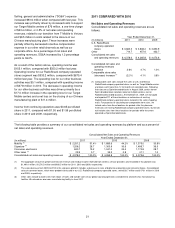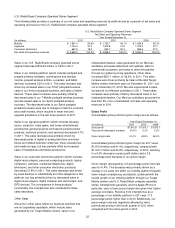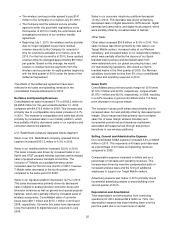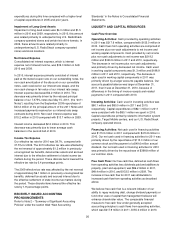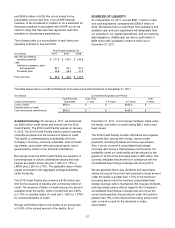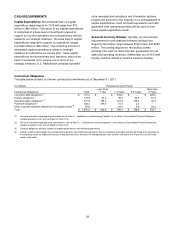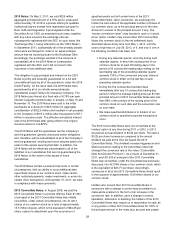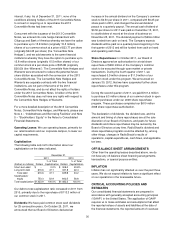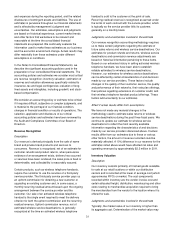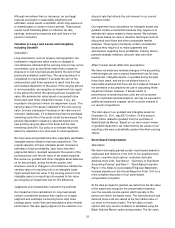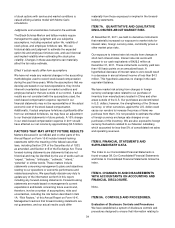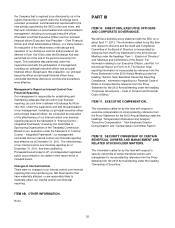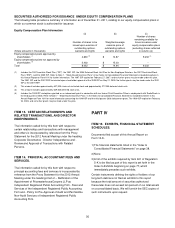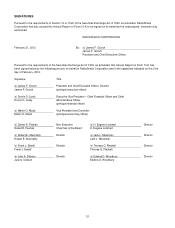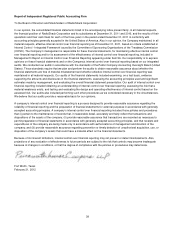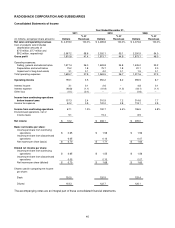Radio Shack 2011 Annual Report Download - page 39
Download and view the complete annual report
Please find page 39 of the 2011 Radio Shack annual report below. You can navigate through the pages in the report by either clicking on the pages listed below, or by using the keyword search tool below to find specific information within the annual report.31
and expenses during the reporting period, and the related
disclosures of contingent assets and liabilities. The use of
estimates is pervasive throughout our financial statements
and is affected by management’s judgment and
uncertainties. Our estimates, assumptions and judgments
are based on historical experience, current market trends
and other factors that we believe to be relevant and
reasonable at the time the consolidated financial
statements are prepared. We continually evaluate the
information used to make these estimates as our business
and the economic environment change. Actual results may
differ materially from these estimates under different
assumptions or conditions.
In the Notes to Consolidated Financial Statements, we
describe the significant accounting policies used in the
preparation of our consolidated financial statements. The
accounting policies and estimates we consider most critical
are revenue recognition; inventory valuation; estimation of
reserves and valuation allowances specifically related to
insurance, tax and legal contingencies; valuation of long-
lived assets and intangibles, including goodwill; and stock-
based compensation.
We consider an accounting policy or estimate to be critical
if it requires difficult, subjective or complex judgments, and
is material to the portrayal of our financial condition,
changes in financial condition or results of operations. The
selection, application and disclosure of our critical
accounting policies and estimates have been reviewed by
the Audit and Compliance Committee of our Board of
Directors.
Revenue Recognition
Description
Our revenue is derived principally from the sale of name
brand and private brand products and services to
consumers. Revenue is recognized, net of an estimate for
customer refunds and product returns, when persuasive
evidence of an arrangement exists, delivery has occurred
or services have been rendered, the sales price is fixed or
determinable, and collectability is reasonably assured.
Certain products, such as wireless telephone handsets,
require the customer to use the services of a third-party
service provider. The third-party service provider pays us
an upfront commission for obtaining a new customer or
upgrading an existing customer and, in some cases, a
monthly recurring residual amount based upon the ongoing
arrangement between the service provider and the
customer. Our sale of an activated wireless telephone
handset is the single event required to meet the delivery
criterion for both the upfront commission and the recurring
residual revenue. Upfront commission revenue, net of
estimated wireless service deactivations, is generally
recognized at the time an activated wireless telephone
handset is sold to the customer at the point-of-sale.
Recurring residual revenue is recognized as earned under
the terms of each contract with the service provider, which
is typically as the service provider bills its customer,
generally on a monthly basis.
Judgments and uncertainties involved in the estimate
Our revenue recognition accounting methodology requires
us to make certain judgments regarding the estimate of
future sales returns and wireless service deactivations. Our
estimates for product refunds and returns, wireless service
deactivations and commission revenue adjustments are
based on historical information pertaining to these items.
Based on our extensive history in selling activated wireless
telephone handsets, we have been able to establish
reliable estimates for wireless service deactivations.
However, our estimates for wireless service deactivations
can be affected by certain characteristics of and decisions
made by our service providers. These factors include
changes in the quality of their customer service, the quality
and performance of their networks, their rate plan offerings,
their policies regarding extensions of customer credit, and
their wireless telephone handset product offerings. These
factors add uncertainty to our estimates.
Effect if actual results differ from assumptions
We have not made any material changes in the
methodology used to estimate sales returns or wireless
service deactivations during the past three fiscal years. We
continue to update our estimate for wireless service
deactivations to reflect the most recently available
information regarding the characteristics of and decisions
made by our service providers discussed above. If actual
results differ from our estimates due to these or various
other factors, the amount of revenue recorded could be
materially affected. A 10% difference in our reserves for the
estimates noted above would have affected net sales and
operating revenues by approximately $2.3 million in 2011.
Inventory Valuation
Description
Our inventory consists primarily of finished goods available
for sale at our retail locations or within our distribution
centers and is recorded at the lower of average cost (which
approximates FIFO) or market. The cost components
recorded within inventory are the vendor invoice cost and
certain allocated freight, distribution, warehousing and other
costs relating to merchandise acquisition required to bring
the merchandise from the vendor to the location where it is
offered for sale.
Judgments and uncertainties involved in the estimate
Typically, the market value of our inventory is higher than
its aggregate cost. Determination of the market value may


